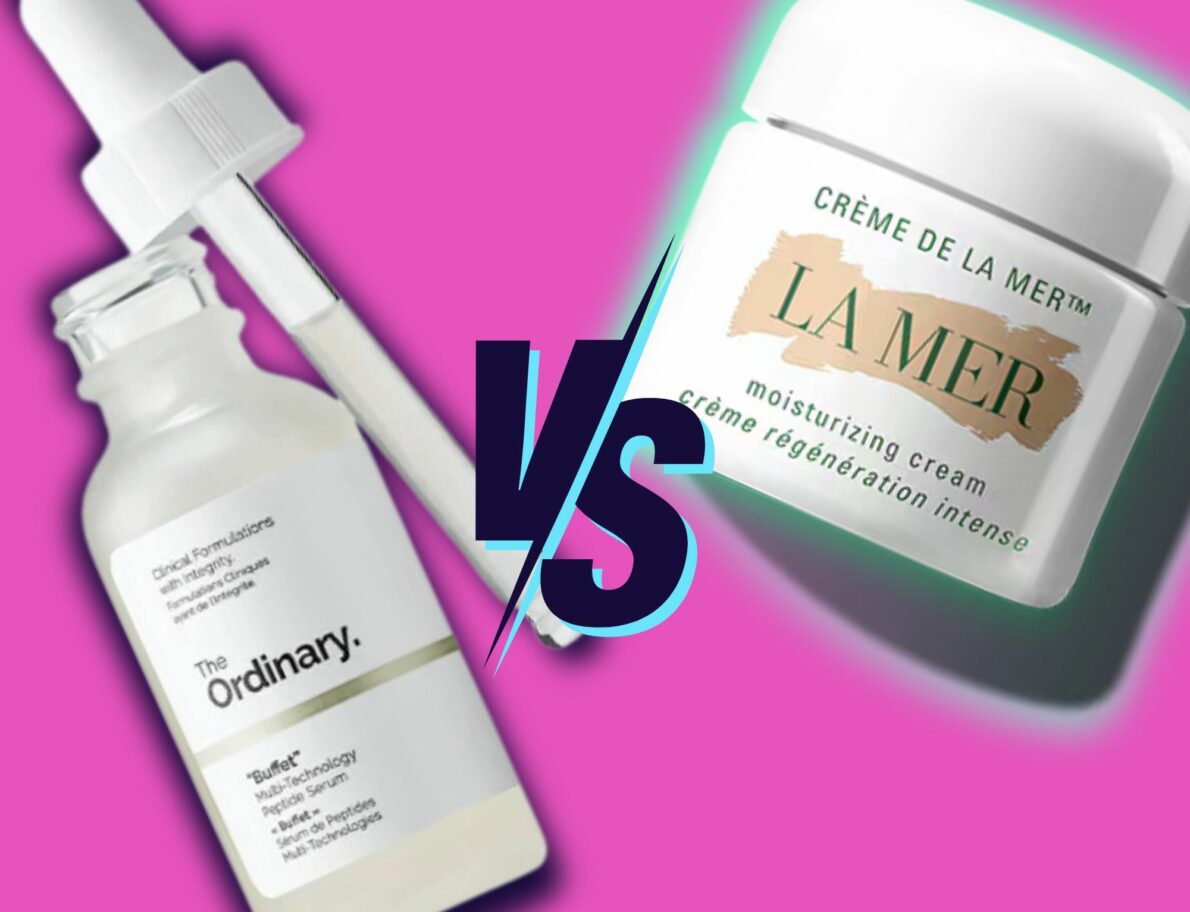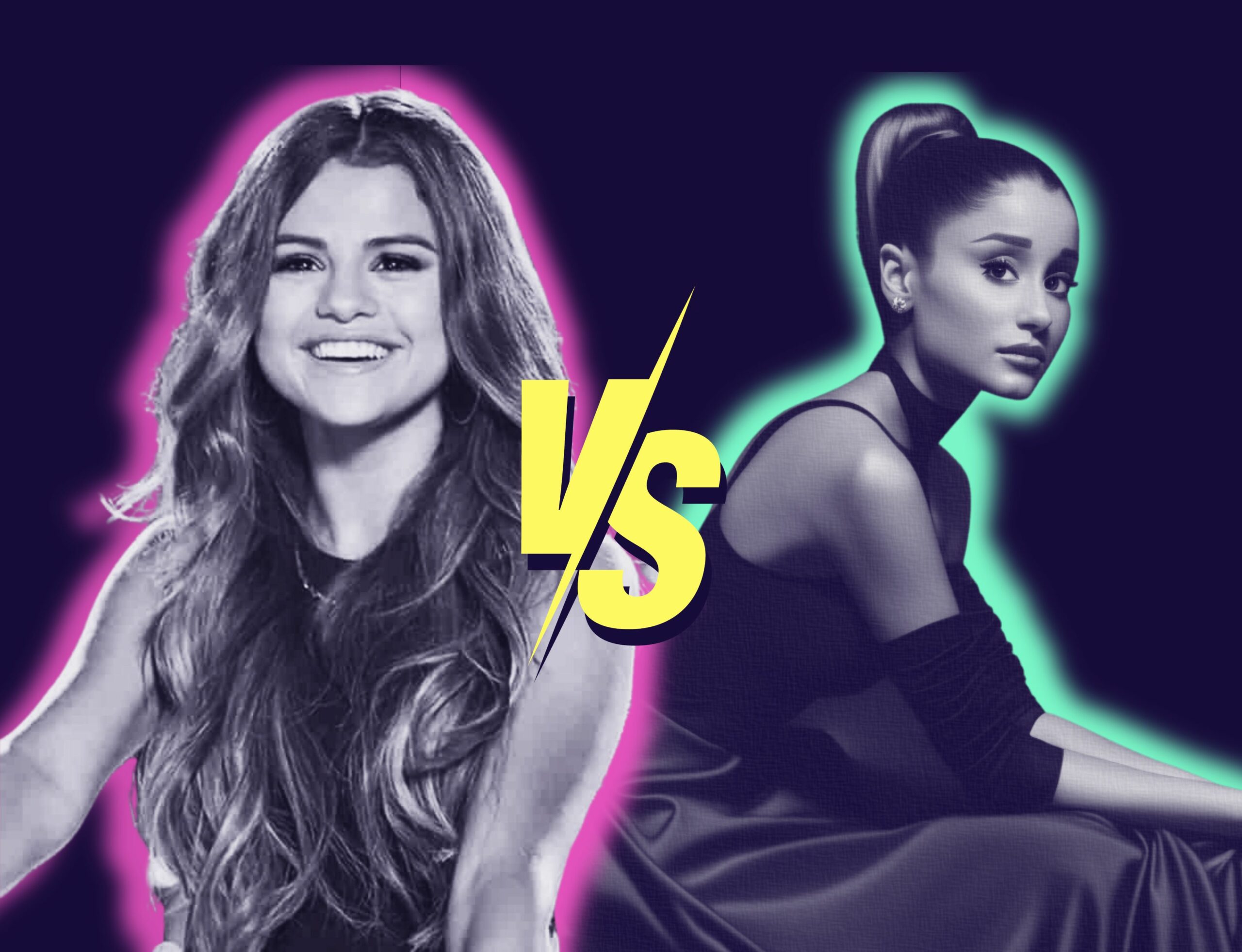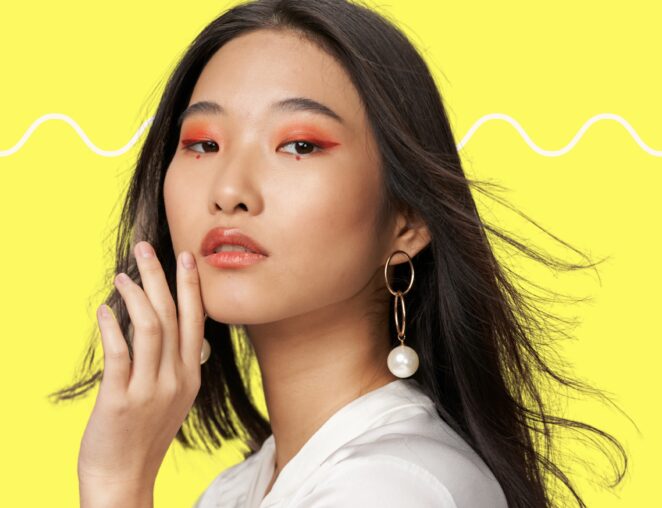What you’ll learn
Facial moisturizer costs under $20 at The Ordinary while La Mer charges upwards of hundreds of dollars. Yet, both skincare giants boast market valuations that surpass $2 billion.🤯 How can they both achieve such success with drastically different pricing?
One word: marketing.
At Lyon Content, we know that digital marketing can take many shapes and strategies. That’s exactly what we see when we compare The Ordinary marketing strategy to La Mer’s — yet both are wildly profitable.
Join us as we stack up the skincare marketing strategies of both the luxury and budget brand, featuring insights from our in-house beauty writing expert, Natalie Laffont.
Before we dissect their tactics, let’s see who these skincare brands are.
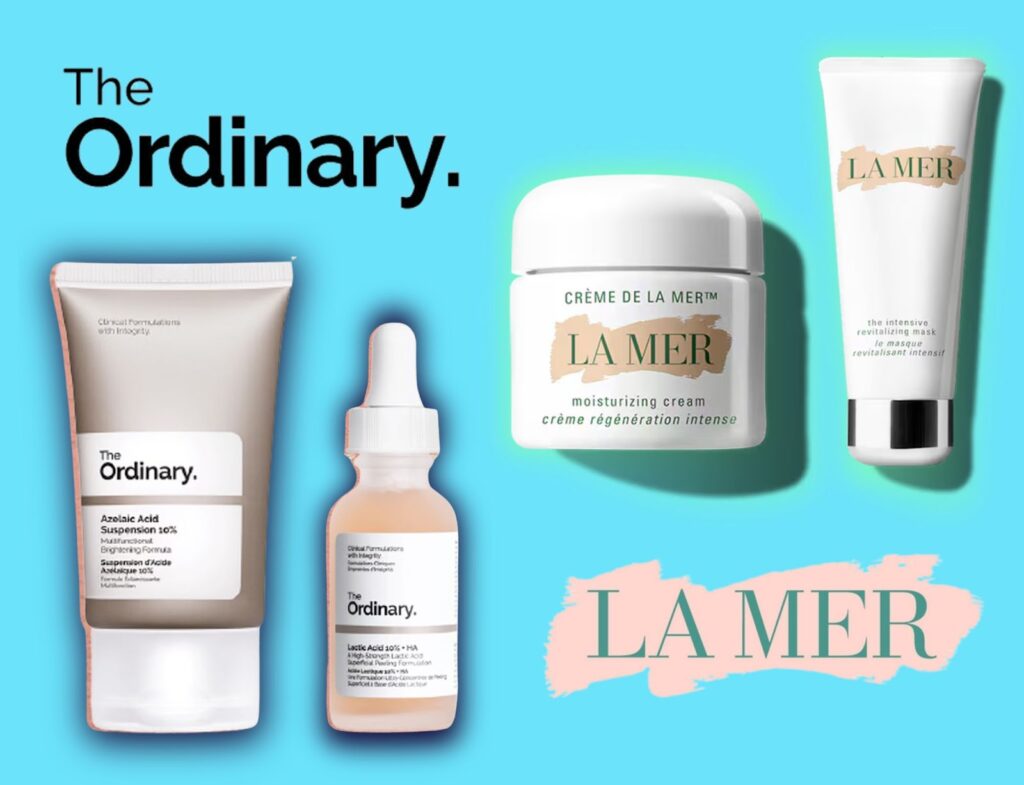
Who are The Ordinary and La Mer?
La Mer
Launched in 1956, La Mer is a luxury skincare brand that sells expensive skincare products ($200+), the most famous being an anti-aging moisturizer made with Giant Sea Kelp harvested from Vancouver Island.
The company also sells eye treatments, face oils, men’s skincare products, body lotions, and toners. While it has a prominent online presence, most of its marketing and sales are conducted in luxury department stores like Saks Fifth Avenue.
The Ordinary
The Ordinary is a functional beauty brand with a wide range of products. Its product lineup contains active ingredients for various skin conditions as well as general skincare items.
Price points are much more affordable (for example, $10 for hyaluronic acid), and marketing is largely focused on online campaigns that feature relatable models and everyday people.
Comparing Audiences: The Ordinary Marketing Strategy vs. La Mer
Just one ounce of La Mer’s Crėme de La Mer costs $200. Naturally, the heritage brand attracts a high-income clientele. You’d think this would indicate an older customer base, which was certainly the case pre-COVID, when most of the company’s sales came from upscale retail locations.
However, a shift to online marketing drove a surge in purchases from younger audiences under 35, particularly in China.
Natalie says La Mer’s audience is shaped more by shared values than age:
“La Mer’s target audience values luxury, exclusivity, and prestige, which is why its narrative revolves around unique formulas (like its Miracle Broth), and a lifestyle that promises both transformation and elegance,” she explains.
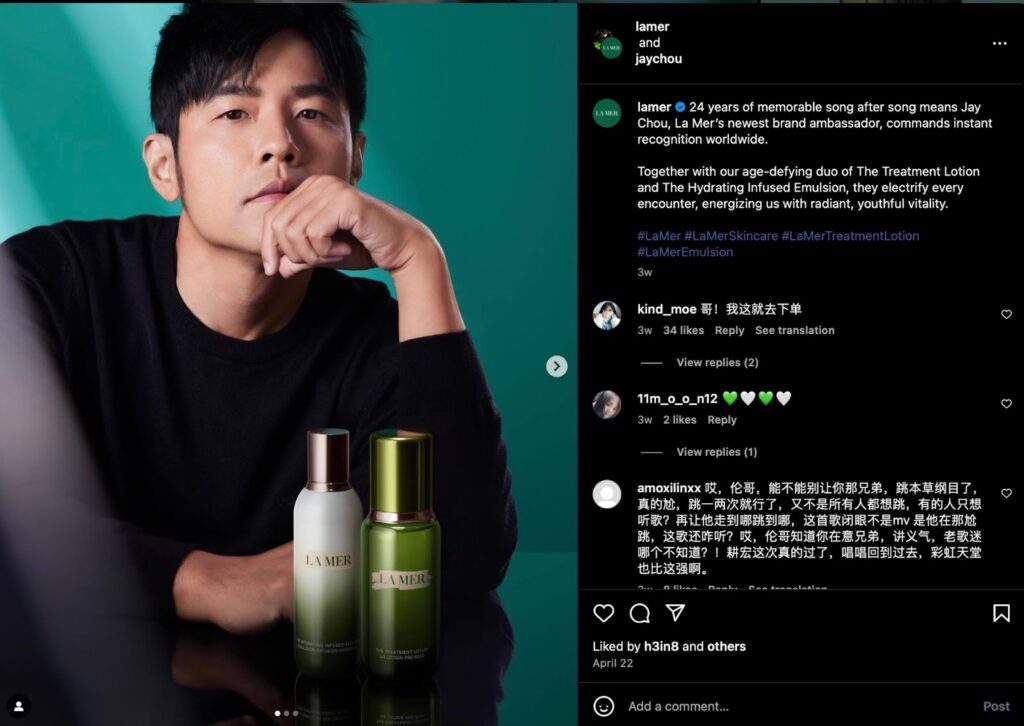
But The Ordinary’s audience is a bit more lowkey.
The Ordinary’s more affordable pricing makes it a hit among younger audiences, as evidenced by its success on the Gen-Z-dominated TikTok platform.
In contrast, La Mer’s TikTok presence is modest, with only about 31,000 followers compared to The Ordinary’s impressive 1.6 million. You’ll also notice The Ordinary’s models and content creators are typically in their 20s to 30s, aligning perfectly with its younger audience:
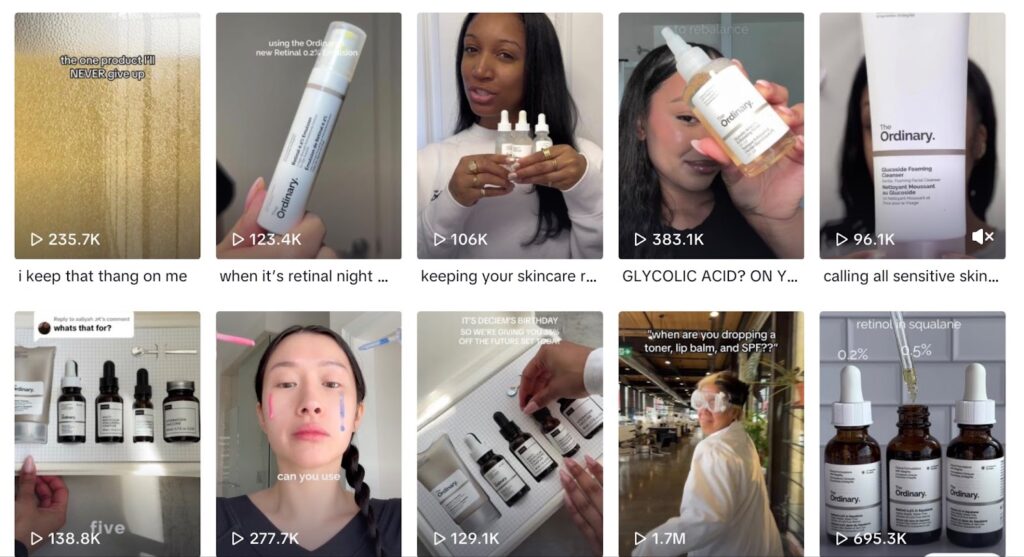
La Mer, on the other hand, embraces videos with creators of varied ages:
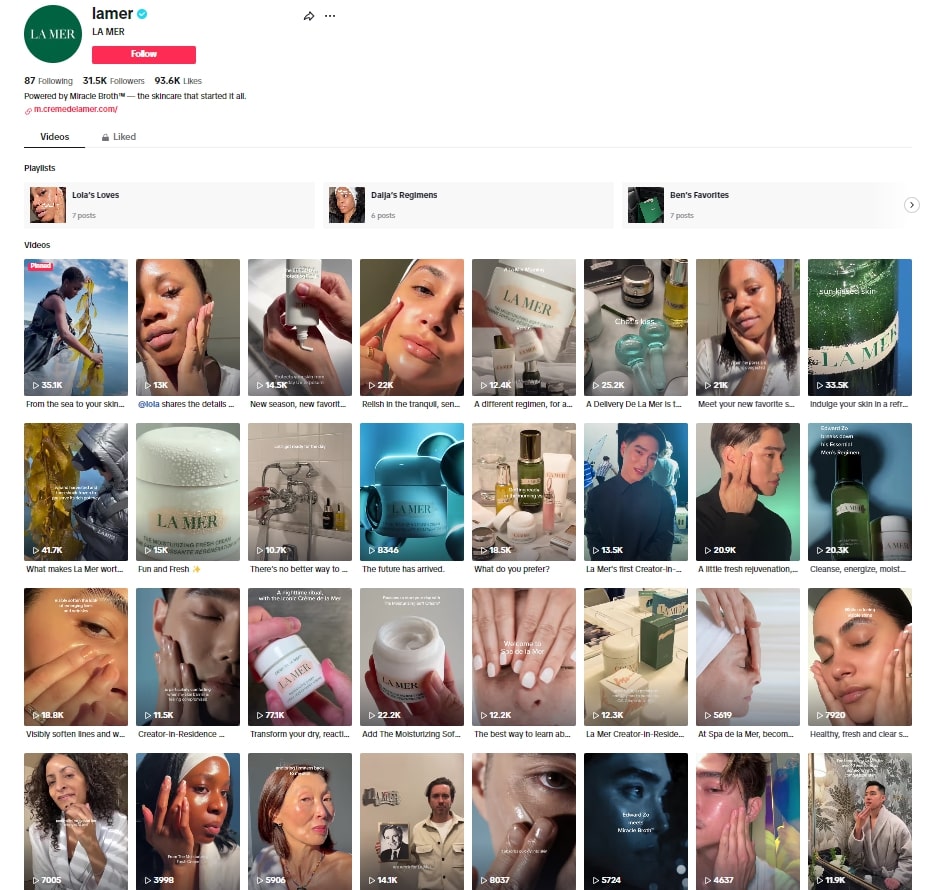
That said, even older audiences with tighter budgets use The Ordinary’s products.
Natalie says this is because their audience transcends age:
“The Ordinary appeals to consumers who prioritize transparency, simplicity, and scientific integrity,” she says. “They focus on offering straightforward, active ingredients at accessible prices, which attracts a demographic who believes practicality and efficacy trump luxury.”
The ordinary marketing strategy vs. La Mer: How is their brand messaging different?
Like many luxury brands, La Mer’s marketing strategy channels exclusivity and scarcity in its messaging. The goal? Make their customers feel like they’re part of an exclusive club:
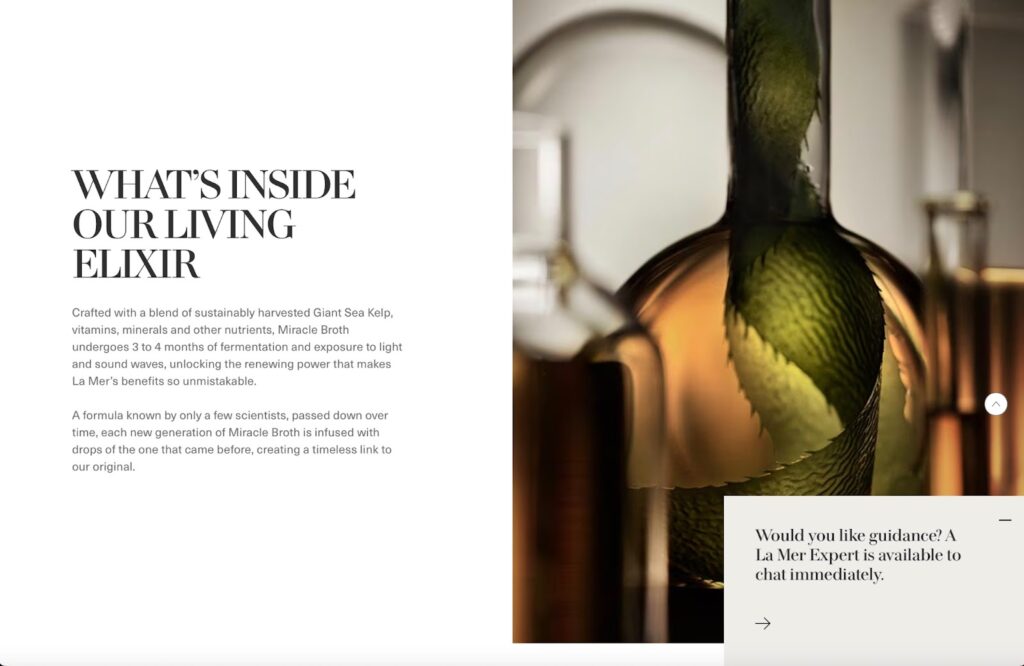
Just look at the intentional, luxury copywriting choices:
La Mer doesn’t say “cream” — they say elixir.
Instead of “effective?” Renewing power.
New bottle? No, it’s a new generation.
But the most striking examples of exclusivity in the copy come in the second paragraph:
- “A formula known by only a few scientists”
- “Miracle Broth is infused with drops of the one that came before, creating a timeless link to our original”
This type of exclusive language imparts La Mer’s audience with one clear thought: there’s nowhere else to get this product. And that’s exactly what the company wants to convey.
These attributes also speak to La Mer’s biggest draws, which set them apart from competitors.
Natalie channeled a similar sentiment when writing content for our luxury alternative hair brand client, Daniel Alain:
“The language should mirror the superior quality of their product line, emphasizing exclusivity, quality, and of course, their unique value propositions (UVPs)” she explains.
Contrast that with The Ordinary’s web copy below:
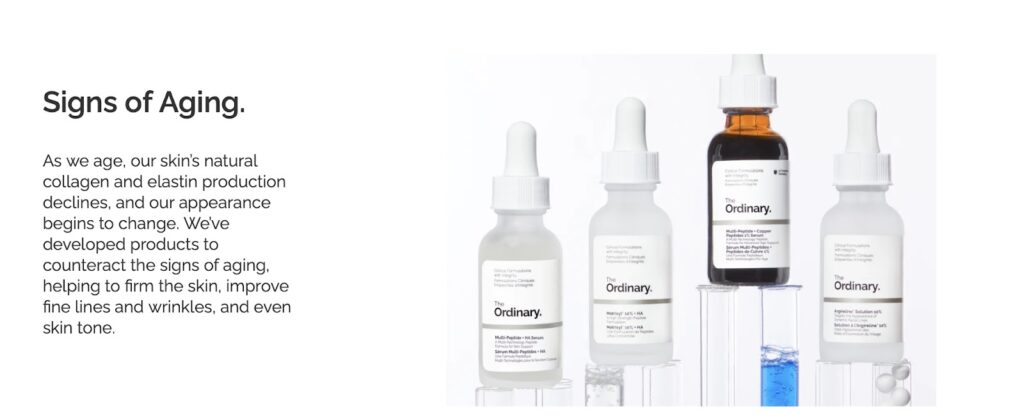
Unlike La Mer’s poetic prose, the messaging here is straightforward, accessible, and ostensibly more honest.
This brand isn’t focused on selling an image of exclusive luxury. Instead, The Ordinary prioritizes clear, factual descriptions of their product ingredients and benefits.
Customer pain points are also front and center:
- “Counteract the signs of aging”
- “Firm the skin”
- “Improve fine lines and wrinkles”
- “Even skin tone”
Now, let’s see how each brand’s messaging translates to their social media posts.
The Ordinary vs. La Mer: Social Media Content
Both La Mer and The Ordinary use TikTok, Instagram, Facebook, and Pinterest. But The Ordinary takes the lead with more activity and engagement across all platforms.
That’s because La Mer has typically focused on traditional print and in-person marketing (more on that shortly). Still, they successfully married this strategy with Pinterest ad campaigns, offering anyone who interacted with their ads free samples.
While the ads aren’t publicly accessible right now, we know from the data published in Pinterest’s case study that this hybrid offline-online approach doubled their brand reviews and quadrupled their engagement rate compared to other Pinterest campaigns.
More reviews meant more sales, likely because 93% of buyers rely on online reviews before they buy a product, especially before they shell out hundreds on one.
Next, let’s explore each brand’s visual storytelling on the gram.
Beauty Instagram Captions: Elegance and Prestige vs. Simplicity and Honesty
La Mer
Captions on La Mer’s Instagram echo its website’s exclusive, elite tone. The same goes for its photos, which feature airbrushed models of different races and genders. This diversity suggests that anyone can indulge in the level of luxury La Mer’s skincare products offer.
Still, the photos highlight near-perfect skin and flourish with naturalistic aesthetics, which may not resonate with your everyday consumer:
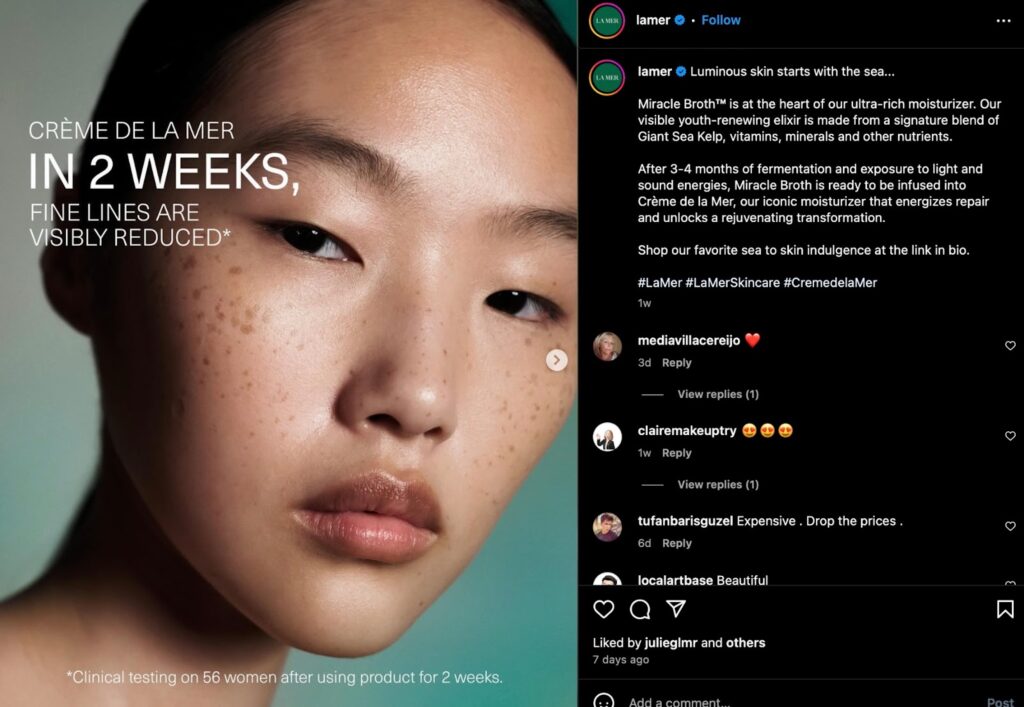
If it isn’t relatable, why does it work? Natalie chimes in:
“At that price point, you have to do more than market a product — you have to market a lifestyle, an experience that justifies such an investment,” she says.
The Ordinary
The Ordinary, on the other hand, seamlessly mirrors the lives of their target audience.
Their posts feature user-generated content (UGC) from micro-influencers that appear more relatable on Instagram. That’s why they generate higher engagement rates and social media activity from their audiences than influencers with large followings — plus, they’re more affordable to partner with.
They don’t use professional models or celebrity collaborations because those aren’t their target audience. The people in The Ordinary’s posts have a more relatable look, including facial imperfections, authentic expressions, and with minimal editing:
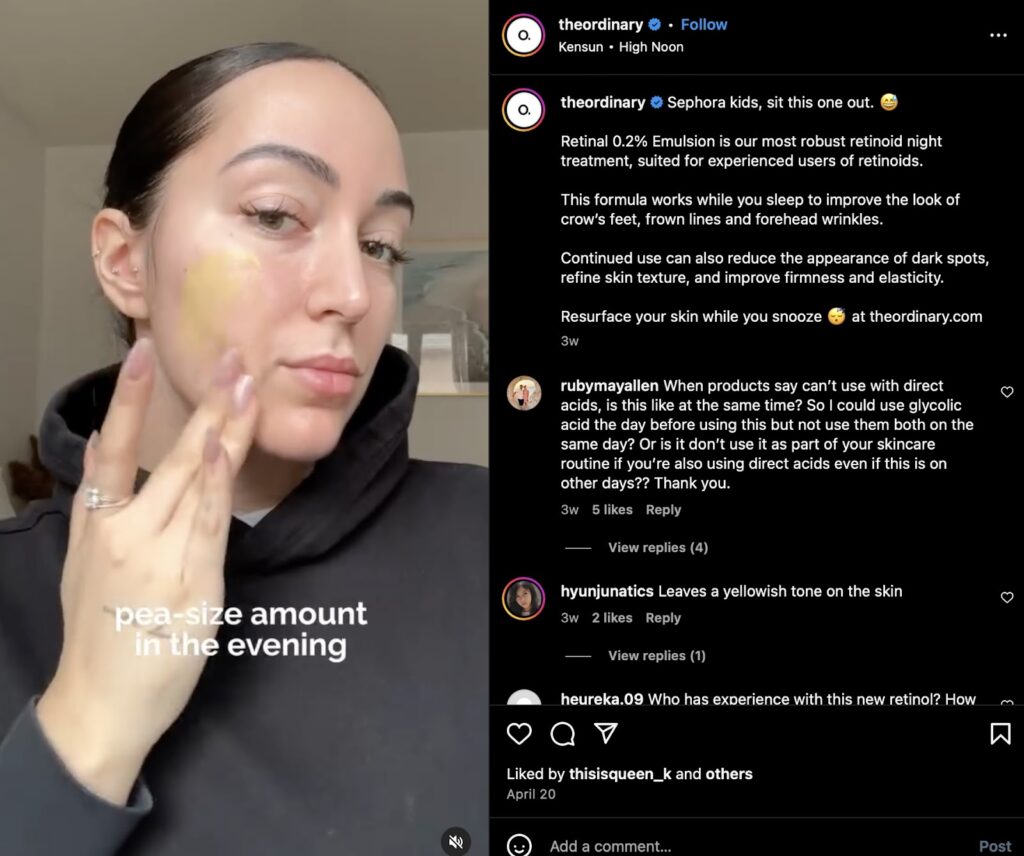
“The Ordinary’s audience values realness, which is why their approach works better for them,” says Natalie. “La Mer, however, presents a more idealized image that resonates more with their embodiment of high-end perfection.”
What about offline strategies?
Traditional Beauty Marketing
Traditional marketing is how brands have long advertised their products, even in the digital age. This spans product packaging, billboards, endorsements, printed mail ads, and notable collaborations.
For instance, Natalie points to La Mer’s collaborations with actresses like Ana de Armas and Simone Ashley, as well as their partnership with Baccarat Hotel in New York City.
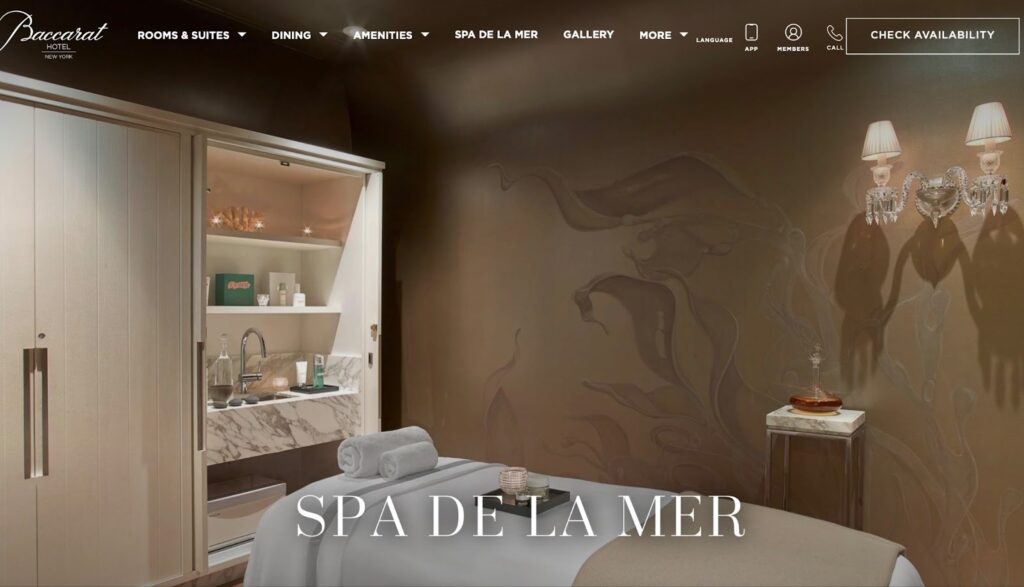
Why’s this a savvy move for La Mer? By teaming up with a luxury hotel brand like Baccarat, they boost their reputation and brand recognition, while reinforcing their premier status.
Plus, these high-end guests will feel right at home when they associate La Mer with their swanky accommodations:
“This type of marketing appeals to consumers who like the idea of being associated with high-status brands,” says Natalie. “Let’s face it — if La Mer partnered with your local budget motel, it wouldn’t exactly scream luxury, would it? 😅”
While The Ordinary leans mainly on digital marketing, they still mix in some traditional tactics, like these eye-catching NYC subway ads:
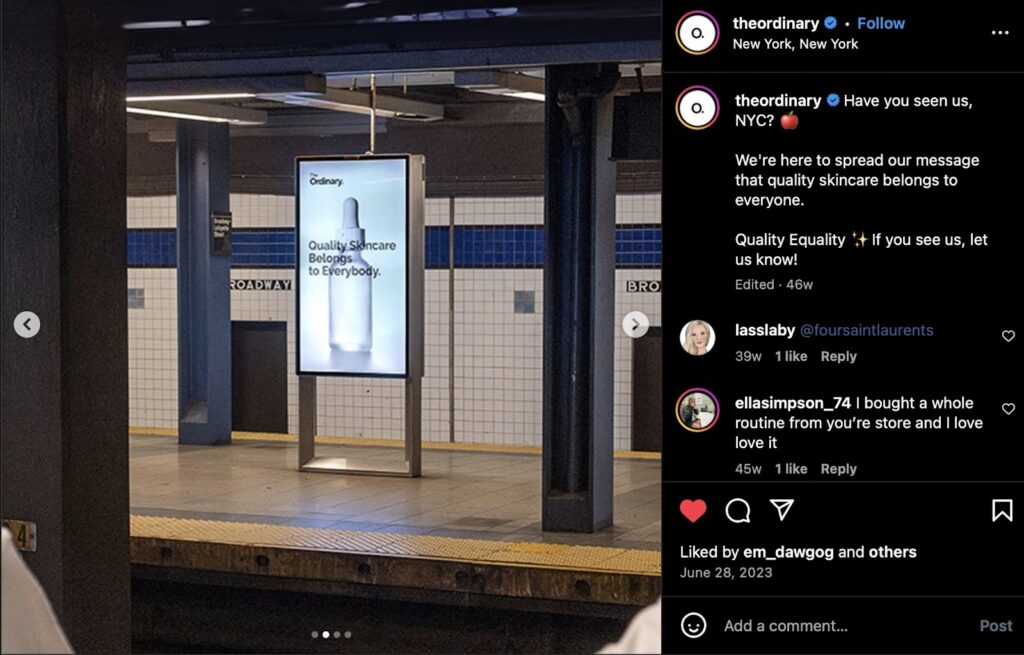
In fact, this campaign vibes effortlessly with the brand’s values of accessibility and simplicity. The slogan, “Quality Skincare Belongs to Everybody” speaks volumes. Plus, what’s more relatable than waiting for the subway train?
“The Ordinary engages a community that favors detailed, no B.S. messaging about ingredients and benefits,” says Natalie. “This appeals to anyone who wants to make informed buying decisions based on efficacy vs. prestige.”
The Ordinary marketing strategy vs. La Mer: Blog Content
La Mer and The Ordinary both post similar types of blog content, like:
- Specific product guides and introductions (e.g. Meet the New Retinol 0.2 Emulsion)
- General product guides (e.g. facial serums)
- Routines by skin type (e.g. skincare routine for oily skin)
Since The Ordinary features more product types and active ingredients, we see more ingredient guides on their blog like this one on squalane. Both blogs have a balance of articles about general skincare education and product promotions.
But just like their branding, each skincare blog’s strategy takes a vastly different approach to their writing style. We see the first difference in the blog names — Journal De La Mer vs. The O. Blog.
The O. Blog
Peep this example from The Ordinary’s blog about its new Milky Toner:
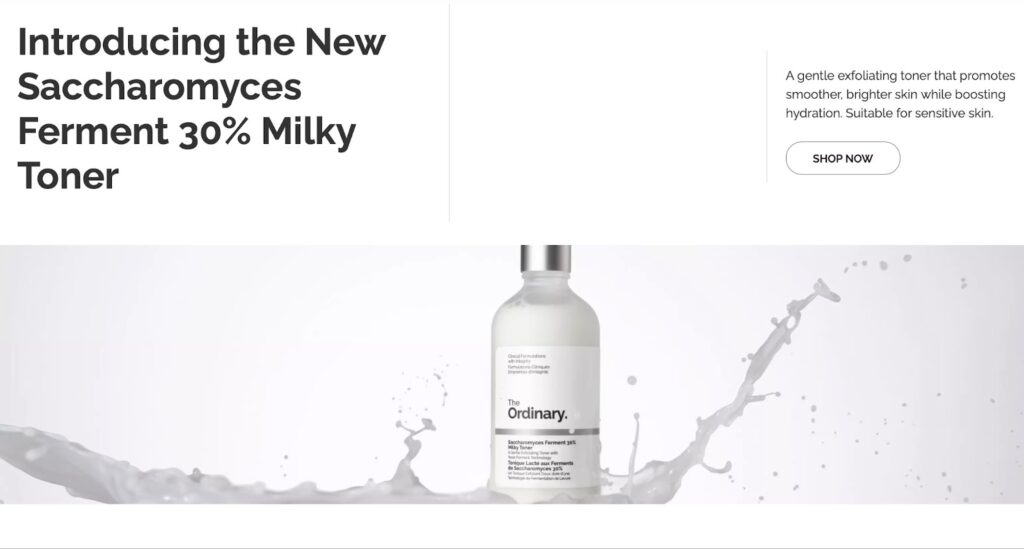
Like most of The Ordinary’s product descriptions, the top-right corner is a matter-of-fact rundown of the toner’s benefits: hydration, brighter skin, and smoothness. As you scroll down, you’ll see information about the product’s biotechnology.
Despite the intricate innovation behind the ingredients, The Ordinary’s copy remains accessible and logical, yet feels like an explanation from a skincare-savvy guide:
“One way we use biotechnology in our Saccharomyces Ferment 30% Milky Toner is with our NAG ingredient…Historically, NAG was sourced from organisms like algae and plants, and Squalane from the livers of sharks. Biotechnology and fermentation allow us to replicate these ingredients without unnecessary harm to animals, or intensive farming.”
PS: Struggling to explain complex ingredients to your target audience? Our skilled beauty content writers can turn snooze-worthy jargon into a joyride for the eyes. ✨
Journal De La Mer
Now, let’s take a look at La Mer’s article on the best moisturizers for different skin types, where they feature their own products:
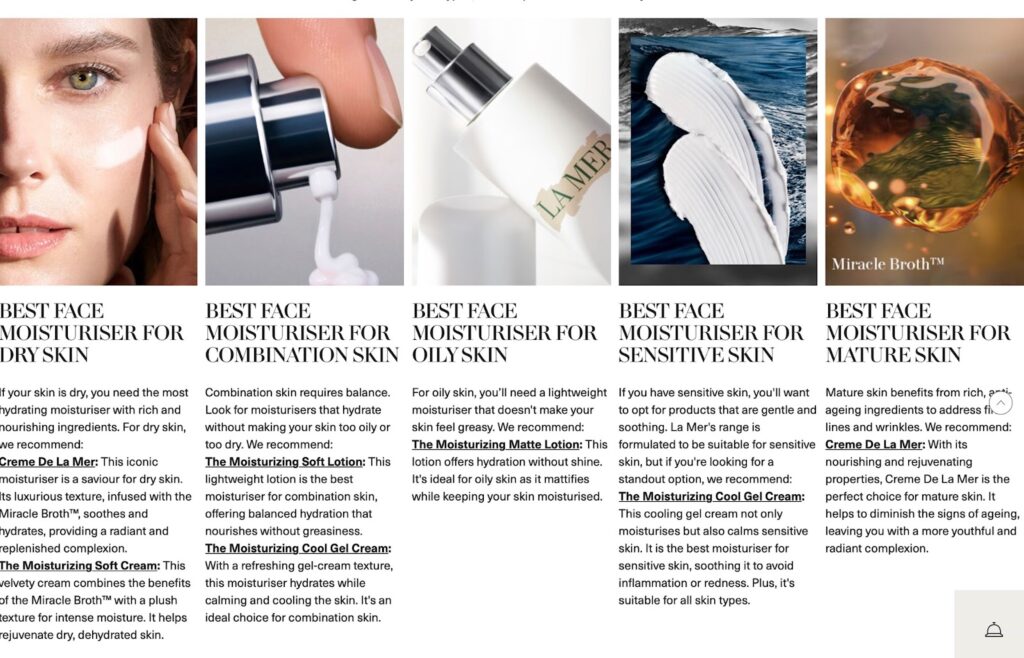
Notice how La Mer’s adjectives exude more grandeur compared to The Ordinary’s to-the-point language? We see phrases like:
- Plush texture
- Savior for dry skin
- Radiant and replenished
- Best face moisturizer for mature skin
Soothing and hydrating? Absolutely! But claiming to be the BEST choice among millions of skincare products? That’s a bold promise La Mer must uphold, especially given the higher price tag.
According to Natalie, their content definitely strikes the right chord:
“La Mer’s messaging shows that the premium price point is a gateway to superior quality or experiences that cheaper competitors can’t provide.”
Budget vs. Luxury Marketing: Who Comes Out On Top?
The Ordinary’s marketing strategy focuses on relatable, minimalistic copy and visuals that highlight its products’ accessibility, effectiveness, and affordability.
On the other end of the skincare spectrum is La Mer’s promise of indulgence and a one-of-a-kind skincare experience that’s just as important as the results.
So, which is the better skincare marketing strategy? Here’s our verdict:
The Ordinary slays with relatable UGC and social media messaging that aligns flawlessly with its mission to make skincare accessible to everyone.
And in a time where traditional marketing seems all but dead, La Mer proves that being out of reach to everyone makes you the perfect match for the few.
Need a beauty marketing partner in your corner to convert your unique skincare audience?
We’re your skincare marketing team. 😉
Lyon Content is an award-winning SEO and copywriting agency that has crafted thousands of articles, landing pages, and product descriptions for both luxury and budget beauty brands (just browse our case studies).
Ready to dazzle your audience? Start your beauty project with us today! 💋

06/22/2024
Chrissy is a contributing writer at Lyon Content based in Toronto. She loves writing and editing tech, marketing, and lifestyle content. But her favorite part of writing is helping businesses express themselves. When she isn't writing, she's traveling as much as possible and eating a lot of cheese.

